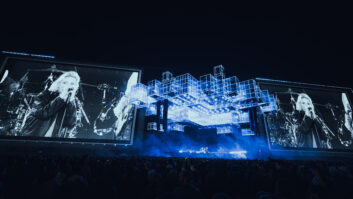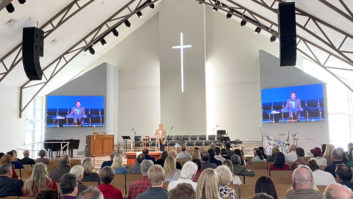
The influx of manufacturers with a broadcast heritage into the AV market over the last half-decade underlines the level of convergence now taking place between the two sectors. And for corporate customers in particular, the result has been an increase in quality and flexibility, writes David Davies.
The gradual awakening of the corporate market to the possibilities of high-end AV has been one of the sector’s greatest success stories over the past ten years. Speak to nearly any vendor that you can think of and they will almost invariably point to at least some level of growth in the corporate sector – while for many it has become very big business indeed.
Although corporate customers have certainly benefited from the greater availability of pro-level audio – most obviously for conferencing and intercom applications – it would be fair to say that the most notable shift has surrounded the use of video. The expectation that it will be possible to take video from multiple familiar sources has been one primary driver – and so, increasingly, has been the accommodation of higher-resolution options such as 1080p and 4K.
With the quality expectations of videoconferencing continuing to grow, and the desire to make greater use of streamed contributions, the pace of change continues to accelerate. While integrators and consultants are enjoying a boom-time for new projects, vendors who are able to provide suitably flexible video solutions have been able to reap tremendous rewards.
Not surprisingly, these opportunities have also attracted manufacturers whose heritage lies not primarily in traditional AV, but in broadcast – where the requirement to deliver and process a variety of video sources is, quite literally, mission-critical. With an increasing number of businesses also looking to invest in powerful IP backbones, the already-evident convergence between the two worlds is on course to intensify greatly.
Vendor versatility
While the extent to which broadcast-centric manufacturers have ventured into traditional AV inevitably varies considerably, all concur that the opportunities present in the latter have increased as the divide between the two markets has closed. Accordingly, this is leading many manufacturers to develop products that can accommodate the requirements of both markets, or even separate ranges that chime with the convenience and easy-use expectations of AV users.
“The convergence taking place is pretty extensive,” says Bryce Button, product marketing manager at interface and conversion technology specialist AJA Video Systems. “We have aggressively positioned ourselves for that kind of thing for around the last five years” – a period in which the development of solutions to appeal to multiple markets has been a priority: “Yes, absolutely. We hired a product market manager to go after such markets [with the result that we now have interests in] live events and fixed structures as well as the professional broadcasting end.”
Australian broadcast and production equipment manufacturer Blackmagic Design, meanwhile, is seeing an increasing variety of its solutions resonate with corporate customers. “Our converters and other ‘glue’ products have been used widely in the corporate market for years, but we’re now starting to see more and more companies looking at our production equipment, such as our switchers and cameras. At a time when budgets are being squeezed, corporate AV teams want solutions that can deliver great quality at great value, and that’s exactly what they’ve seen from our kit,” says Luke Mahler-Hausen, AV and live business development, EMEA, Blackmagic Design.
Conversion technology specialist tvONE has “always bridged the two worlds”, says vice president sales and marketing Andy Fliss, who pinpoints the influence that broadcast is exerting on traditional AV. “To the broadcast industry the stability of the technology is mission-critical, and manufacturers serving that industry design to that standard. Commercial AV tends to be a more price-competitive market, and the industry tends to design to a budget. Personally, I hope that as broadcast manufacturers grow in the commercial market they will reset expectations in terms of what the quality and reliability of technology ought to be.”
James Keen, marketing manager at IPTV and VOD streaming company Tripleplay Services, also thinks there may be an overall increase in standards – although a certain degree of adaptation will also be necessary. “The emergence of broadcast tech into AV will drive up quality, potentially,” he suggests. “The AV market will have to start getting to grips with answering broadcast queries and integration requests. Although that said, the broadcast industry will have to adapt as well – understanding that not all businesses have a need for broadcast-quality video, technology or services, and that the AV industry has been very nicely running along for a number of decades without it.”
He adds, invoking a pleasing metaphor, that “there is a natural marriage between the two industries, but as with any marriage it will take a bit of give-and-take on both sides to deliver a happy ever after”.
www.aja.com
www.blackmagicdesign.com
www.tripleplay-services.com
www.tvone.com







